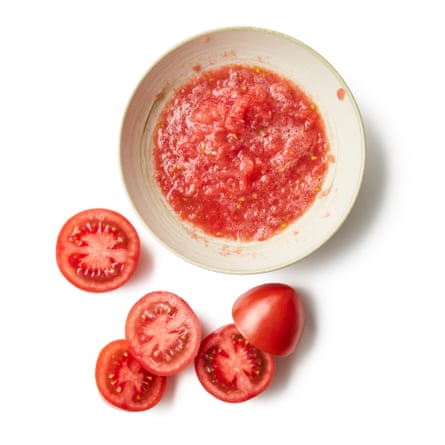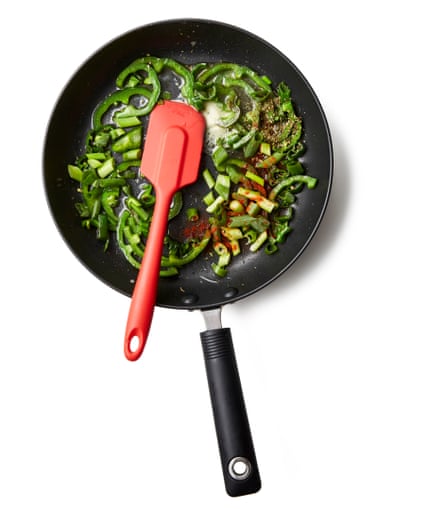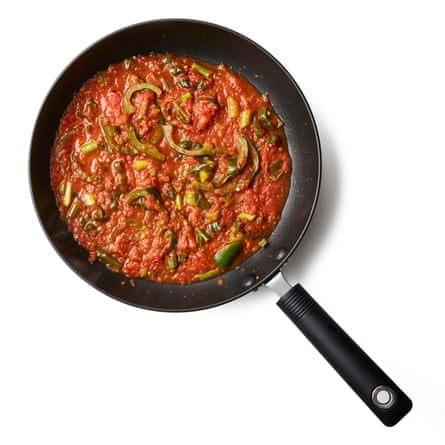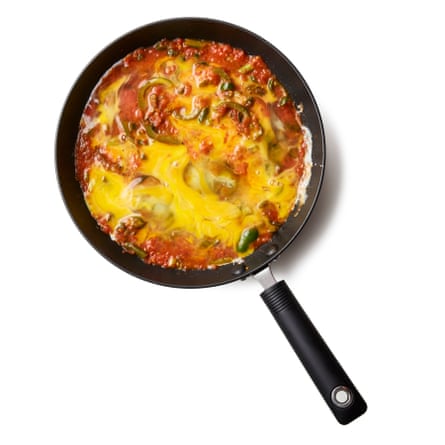Being good Guardian readers, I’m sure you’re all familiar with shakshuka – the north African egg dish that first conquered Israel, and then brunch menus around the world (with a little help from one Yotam Ottolenghi), but you may be less familiar with the (arguably superior) Turkish version, menemen, for which the eggs tend to be stirred into the sauce, rather than simply cooked on top.
“Quick, simple and tasty,” Ghillie Basan writes in her Classic Turkish Cooking, this chunky, tomato-rich stew is something you’ll find in “bus stations, train stations and ports anywhere there is passing trade”. According to Yasmin Khan, it derives its name from the Greek menemnos, “meaning to ‘flood’ or ‘overflow’”, which, as she observes, “makes sense when you see a pan of menemen with its eggs flooded in juicy, sweet tomatoes, just waiting for you to scrape up with some freshly baked pide ekmek”. But, as Somer Sivrioglu explains, though it’s a famous breakfast dish in Turkey, “no one can agree on the perfect version. It varies from village to village and from house to house – even in the Aegean town called Menemen, which is not necessarily its place of origin.” With that in mind, take today’s recipe as my humble contribution to the debate.
The vegetable base

Peppers and tomatoes are the soul of this dish – though green pepper haters, who seem to be legion (on social media, at least), will be disappointed to discover that they seem to be the most popular choice, what with Turkey being an enthusiastic consumer of peppers of all shapes and colours, including the long, slim, pale green sivri biber (literally “hot pepper”, though they vary in pungency) called for by Özlem Warren in her book Özlem’s Turkish Table. These are easily found anywhere that caters to Turkish or Balkan communities, though, if you’re averse to heat, you could swap in the paler green carliston peppers suggested by Basan, or the larger, deeper green, flatter bullhorn/romano peppers mentioned by Sivrioglu in Anatolia, which he co-authored with David Dale, though those are usually sold red in the UK.
J Kenji López-Alt allows that most (English language) home recipes call for a green bell pepper, but, he writes, the best menemens are made “with an entirely different type of green pepper: one that’s thinner, less grassy, with a touch more bitterness and a distinct heat.” He lists Japanese shishito, Chinese long, green horned or padrón peppers as decent substitutes for the Turkish sort, only the last of which are available in my local supermarket. (If you can find only bell peppers, you might want to also add a green jalapeño or another mild chilli, for heat, as Basan recommends.)

Khan’s recipe in Ripe Figs, her book on the cooking of the eastern Mediterranean, is the only one I find that calls for a red pepper. It makes her dish beautifully rich and sweet, but I miss the bitter warmth that the green variety brings to proceedings – if you’re less of a fan, however, you may be reassured to know that you have options. I’m more taken with Khan’s generous hand with the tomatoes; she uses six for two people, which is more than double the amount called for in most other recipes. Not only does this give her dish bags of flavour, but it also helps keep it fairly liquid, which is important, because, as far as I can tell, the worst crime a menemen can be accused of is being dry.
The late Jeremy Round cautions readers of his book The Independent Cook not to even consider making this dish with tinned tomatoes, though in fact López-Alt and Basan both allow them as a substitute for the fresh kind. As someone who steers clear of fresh tomatoes for much of the year, I can usually be relied upon to back the tinned sort, but here they’re too jammy and not acidic enough to be a truly satisfactory stand-in, though if that’s all you have available, they are, of course, better than nothing. That said, Warren confirms that “juicy ripe tomatoes work best, [and] if tomatoes [are] on the less ripe side, some folk may also add a bit of tomato paste to give it depth”.

I also rarely bother to peel tomatoes when instructed, but again, because the aim here is to create a sort of egg soup (bear with me), in which the tomatoes have broken down entirely, bits of floating skin could be fairly regarded as a nuisance. Peeling and chopping isn’t much of a faff, but I’ll be honest, it’s easier still to grate them.
Round is the only one who omits onions, with most people going for the yellow sort, with the exception of Sivrioglu, who uses red, and Warren, who calls for spring onions. I’m torn; l love the sweetness of fried onions, but the grassy sharpness of the spring onions appeals to me more at breakfast time. If you prefer the yellow or red ones, then peel, finely dice and add to the pan at the same time as the peppers.
The seasoning

Warren’s spicing is the most minimal; just a couple of teaspoons of Turkish red pepper flakes, also sold as pul biber or aleppo pepper – described by Sue Quinn as “gently fruity, slightly salty red chilli flakes with a soft kiss of heat” in her recent exploration of the impact of ongoing conflict in Syria on its cultivation. If you don’t have any stockists near you, it’s easily found online, but you can, as both Khan and López-Alt suggest, use paprika instead, or the hot chilli flakes that Warren tips as a substitute. It is delicious stuff, though, and well worth seeking out for myriad uses.
Khan and López-Alt both also include oregano, which I like, but which certainly seems to be an optional extra, and Khan garlic, which, while always welcome, isn’t strictly necessary here. (Depending on the ripeness of your tomatoes, you not need the sugar in her recipe either, but taste and see.)
The eggs

Interestingly, Basan’s recipe fries the eggs in the sauce, which results in a dish more reminiscent of shakshuka and which one correspondent tells me is known as “bus station menemen”, but I prefer the more common, scrambled version. The trick seems to be to keep the eggs as soft and moist as possible – this isn’t huevos a la mexicana, or even scrambled eggs with peppers and tomatoes, as much as an egg-thickened tomato soup, which means the heat should be low and you should take the pan off before the eggs are done to your taste. Sivrioglu prefers his eggs “stirred not scrambled”, so the white and yolk stay fairly distinct, something also cited as important by Serious Eats and several YouTube videos, but as someone who thinks egg white is always improved by fat, I prefer, like Warren and YouTuber Uncle Hajji, to mix them together. Each to their own, however, so I’ve given both methods below.
López-Alt has some advice for getting “the soft texture just right” – he lifts out half of the base before adding the egg, then stirs it back in at the end, when it will “instantly cool the mixture, preventing the eggs from overcooking”. This is a useful tip if you’re making smaller amounts, because the shallower depth of liquid in the pan will cause it to evaporate faster, though it’s probably unnecessary if you’re cooking for two or more.
The cooking medium, method and extras
Oil, either vegetable or olive, is the most common fat used – and plenty of it for the best results – but Basan, Khan and Warren also use butter for extra flavour. Though optional, if you add it, I’d suggest doing so once the peppers have softened, as in Hajji’s extremely wholesome 13-minute video on the subject, so it doesn’t burn.

This is one of those recipes where the method is almost more important than the ingredients; it also requires a bit of judgment on your part, because it’s impossible to give precise timings for different pans and stoves. You need to cook down the tomatoes until they create a thick sauce, but not so much that they dry out, or the eggs will cook on the base of the pan instead of poaching in the sauce, and making an entirely different thing. For this same reason, I’d advise using the smallest frying pan you can comfortably fit everything into.
Warren stirs white cheese into her dish, which is a nice idea if you want to bulk it out, particularly as a brunch or lunch dish, while Basan tops hers with a seriously garlicky yoghurt sauce, which, again, may or may not be to your taste at breakfast time.
I don’t think menemen strictly requires any greenery, but a fistful of chopped parsley, which seems most traditional, coriander or chives, as given by Khan as alternatives, certainly won’t do any harm, and will add a pleasing flash of colour. Really, however, the true beauty is in the eating.
Perfect menemen
Prep 10 min
Cook 15-20 min
Serves 2
4 ripe tomatoes, about 200g
About 90g green peppers, preferably a slightly hot variety such as sivri biber or padrón, or a mix of green peppers and 1 mild chilli
2 spring onions, or 1 small onion
2 tbsp vegetable or olive oil
Salt
1 tbsp butter
1 tsp pul biber/aleppo pepper, or ½ tsp ground paprika
½ tsp dried oregano (optional)
A pinch of sugar (optional)
4 eggs
A little chopped parsley, coriander or chives, to finish (optional)

Cut the tomatoes in half and grate them; discard the skins.

Cut the peppers in half, remove and discard the stems, seeds and pith, then cut the flesh into thin slices (if your peppers are very slender, you can just slice them, seeds and all).
Trim the spring onions and cut both white and green parts into chunky slices (or peel and finely dice the yellow or red onion).

Put the oil in a medium frying pan on a medium-low heat, then saute the peppers, along with a good pinch of salt, and the yellow/red onion, if using, for about five minutes, until soft.

Stir in the butter, spring onions, if using, pul biber and oregano, if using, fry, stirring, for a couple of minutes more, then add the tomatoes, plus a pinch of sugar, if you think they’ll need it.
Simmer gently until the colour of the tomatoes darkens and some, but not all of the liquid has evaporated.
Meanwhile, crack and beat the eggs, unless you’d prefer to keep the two parts separate, in which case crack them whole into the pan and stir them only a little to break the yolks without scrambling them.

Stir (or crack) in the eggs and cook, stirring, until the mixture has firmed up slightly, but not entirely. Top with herbs, if using, and serve with fluffy bread.
-
Menemen: though breakfast shouldn’t be a competition, is it, in fact, the best egg dish going – and if so, what’s your perfect version? And what other personal or regional variations are worth a try?
from "recipes" - Google News https://ift.tt/rksDymZ
via IFTTT

No comments:
Post a Comment